The Cognitive Function Scanner Mobile Neuropsychological Test Suite is the fourth and latest generation of computer-aided test systems in the Cognitive Function Scanner family covering four neurocognitive domains (attention, complex coordination, perceptual-motor functions, and memory). Six tests comprise executive functioning, i.e., visuomotor functioning, visuospatial functioning, visual perception, complex coordination, reaction time, and vigilance, while four tests comprise working memory/delayed recall of faces, words, numbers, and environmental sounds, respectively.
The tests are validated via examination of two stratified random samples of the general population drawn from the Danish National Citizen Registry (N=1,026 and N=711) combined to establish references for subsequent examinations. Each psychometric score is automatically accompagnied by a percentile calculated in realtime on the basis of age-, gender-, and education-matched subgroups from the reference data. Along with the psychometric scores comprehensive response process recordings inspired by the Boston Process Approach are available to facilitate test evaluation in delicate cases.
All psychometric output is stored in standard format files, while all response process recordings are stored in printable jpg-files (a sample can be seen below in relation to the auditory Reaction Time and Vigilance Test). The standard format files holding the psychometric data are of fixed length facilitating easy concatenatenation before establishing datasets for analysis by, e.g., standard statistical software.
The Cognitive Function Scanner Mobile comes with a complete manual (pdf, 100+ pages) with test instructions, comprehensive documentation of specific technical details of the system, and references.
Tests of executive functioning:
- Visuomotor functioning
- Visuospatial functioning
- Visual attention and vigilance
- Complex Coordination
- Auditory reaction time and vigilance
Visuomotor functioning (eye-hand coordination)*
Precise manipulation of tools in response to what eyes see has been a speciality for humans in ancient times. With the introduction of small electronic devices like cell phones, pods, etc., fine-tuned, precise, and rapid movements of the fingers has come inevitable to everybody.

Doing the Figure Drawing Test with a Staedtler Digital Pencil on a Samsung Galaxy Tablet S3 9.7"
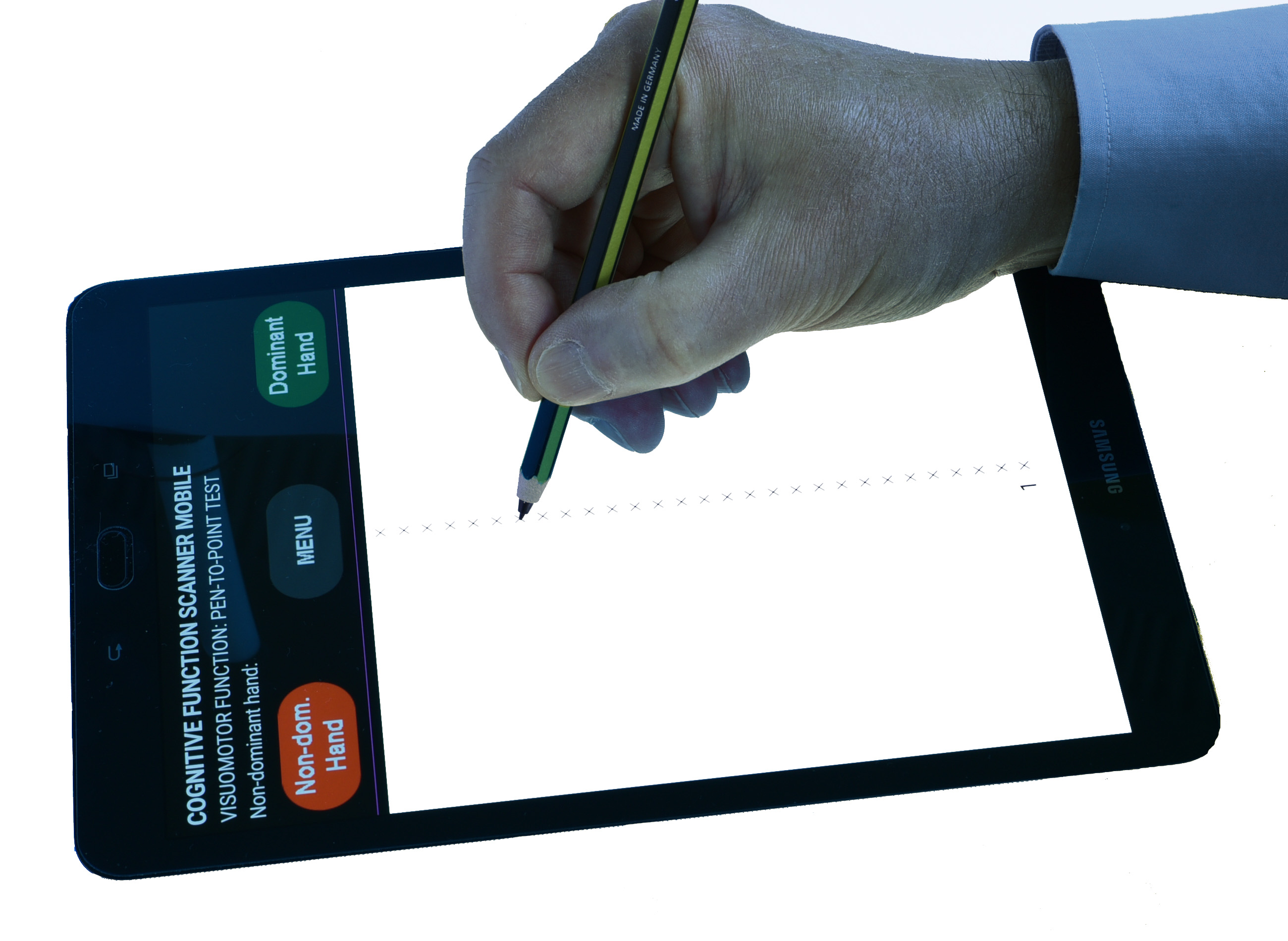
Doing the Pen-to-Point Test with a Staedtler Digital Pencil on a Samsung
Galaxy Tablet S3 9.7"
The Cognitive Function Scanner Mobile Test Suite comprises two tests of visuomotor functioning: the Figure Drawing Test for continuous motion and the Pen-to-Point Test for discrete motion. Both tests are developed especially for the Cognitive Function Scanner system combining experience from various drawing tests and pin-and-peg tests. The two tests are taken separately for each body half/brain hemisphere beginning each test with the dominant hand.
The test layouts are displayed on the tablet. The tablet enters pen-only mode allowing the client to rest his or her hand on the surface during the tests. Width of pen tip is 0.7 mm.
In the Figure Drawing Test the client has to trace a curved line with a digital pinpoint pen without ink (or as on the photo: a digital pencil), while in the Pen-to-Point Test point with the tip of the pen (or digital pencil) as accurately as possible into the centres of small crosses distributed along a straight line in the centre of the screen (simulating a pin-to-hole test). The parameters of each of the two tests are:
Psychometric parameters for each hand:
- Accuracy, 1/10 mm (primary psychometric parameter)
- Speed, 1/10 seconds (primary psychometric parameter).
- Number of pencil lifts (Figure Drawing Test only)
In addition to these psychometric parametres a complete reproduction of the client's drawing is generated to elucidate an eventual neglect problem or other qualiatative signs of dysfunction.
Visuospatial functioning*
Spatial capacity is essential in relation to navigation, driving, reading, writing, etc., etc. Tests of visuospatial functioning come in many variants, some two-dimensional, others three-dimensional. To the Cognitive Functional Scanner systems we have chosen the Parallelogram Test, i.e., a two-dimensional type.
The Parallelogram Test consists of 10 sets of each three parallelograms, all displayed on
the tablet at the same time. Each parallelogram has a thick base line, two of them being
arranged nose-to-nose
on a common line that always points downward towards the
client. The orientation of the baselines of the separate parallelograms in each set
differs from those on the shared baseline. It may point in any direction. The task for
the client is to imagine that he or she rotates the separate parallelogram of each set so
that their baselines become congruent with the ones of the two parallelograms on the common
baseline. Having reached that far the client, using the digital pinpoint pen, must point
out the corner of the congruent parallelogram that corresponds to the dotted corner of
the rotated
parallelogram.
The tablet enters pen-only mode allowing the client to rest his or her hand on the surface during the test.
The psychometric parameters of the test are:
- Number of errors (primary psychometric parameter)
- Response latencies, total in 1/10 seconds (primary psychometric parameter).
In addition to these psychometric parametres a complete response process chart is drawn showing the exact response positions and latencies for each of the single subtasks.
Visual attention and vigilance*
While awake the capability of keeping sustained attention (to maintain a certain level of arousal) is essential for survival. In the Cognitive Function Scanner systems the testing of visual attention and vigilance is done using a modified version of the Bourdon-Wiersma Test, i.e., a test consisting of culture-free graphic objects.
The modified Bourdon-Wiersma Test consists of
37 rows of 25 dot-groups of three, four, or five dots each. The dot-groups are rotated
differently calling for spatial capacity. Each row includes eight
three-dot-groups, nine four-dot-groups, and eight five-dot-groups distributed at random.
The client's task is to search the rows marking all four-dot groups with the pinpoint pen
(or digital pencil) leaving a virtual ink mark
across each detected dot-group.
The ink markings
are used to provide visual feedback and prevent confusion.
Because attention is closely linked to time, time is measured for each row so that
variation in performance time can be used as a measure of vigilance. In addition to time
the number of errors is recorded for each row. The performance of the first and the last
row is excluded from the calculations of the overall performance partly because it cannot
be defined when a client begins searching, and partly because the test should
terminate even if the last dot-groups in the lowest row are not detected/marked.
The psychometric parameters of the test are:
- Total number of missed detections (primary psychometric parameter)
- Total performance time in 1/10 seconds (primary psychometric parameter)
- Fluctuation, (primary psychometric parameter).
- Total number of incorrect detections
- Median time per line in 1/10 seconds
In addition to these psychometric parametres a complete chart of the client's errors (unmarked or incorrectly marked dot-groups) is generated to elucidate an eventual neglect problem or other deficits that need a qualitative approach.
Complex coordination*
The Continuous Graphics Test is a test of simulated handwriting, thus calling for visuospatial capacity, visuomotor capacity, working memory, and capacity to turn a mental image into coordinated action. The Continuous Graphics Test was originally developed by Andersen (1978) to detect subclinical fluctuations in consciousness in epileptics, in whom it was expected that interruption in the neural and psychological processes could be responsible for the lack of continuity during the drawing of the continuous patterns. Although the test was developed for use within a certain group of patients, decreased performance is not related to any specific cerebral disorder.
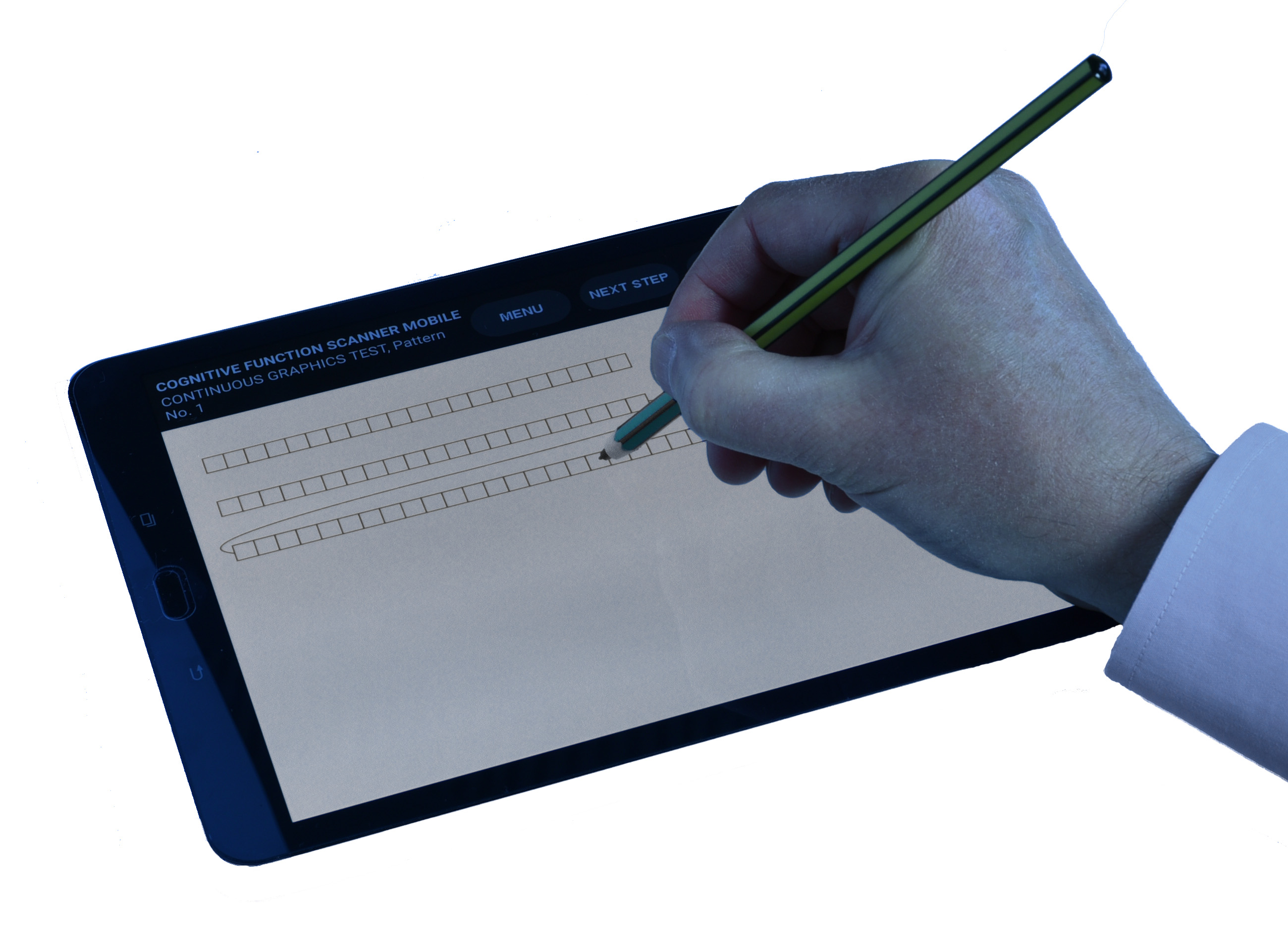
Doing the Continuous Graphics Test using a Staedtler Digital Pencil on a Samsung Galaxy Tablet model S3 9.7" (pattern not shown).
The Continuous Graphics Test used in the Cognitive Function Scanner systems includes three rhythmically shifting graphic patterns. Due to the limited amount of space available on a tablet computer the response line is broken into two parts in the mobile version (in the PC-version the response line is one unbroken string of squares). The client's task is to copy each pattern on the rows of squares (56 squares in total) using the pinpoint pen (or digital pencil) leaving no visual trace, thus delivering no feedback to the client. He or she has the model available only while copying the first repetitions of the patterns on the middle line. The remaining part of the pattern must be filled in from memory. Because of lack of visual feedback from the invisible drawing the client has to remember the pattern, and at the same time be aware of how far he or she has drawn. The performance is automatically scored by means of an artificial neural network especially trained for this task.
The psychometric parameters of the test are:
- Number of errors separately for each pattern (primary psychometric parameters)
- Speed in 1/10 seconds separately for each pattern (primary psychometric parameters)
In addition to these psychometric parametres complete reproductions of the client's drawings are recorded including information on latencies and error positions allowing for qualitative evaluation.
Auditory reaction time and vigilance
The Reaction-time Test in the Cognitive Function Scanner system is a test of continuous simple reaction-time and vigilance over a period of approximately 7 minutes. It is composed of a series of audible stimuli, each as a constant tone at 440 Hz. The tones are randomly distributed with two to six second intervals, and presented to the client via the built-in loudspeaker of the device.
The client responds to the test by swiping the
rim of the device with the wide end of the digital pen. When the app hears
a swipe
the clock is read and the tone stops. The use of audible response-sensing instead of screen
touching eliminates errors due to unknown device-specific touchpad latencies that would
invalidate the measurements. A total of 78 stimuli are given, of which the first
three are omitted from the analysis. They are present to allow the client a chance to
familiarize with the stimuli and for the psychologist to check if the client complies with
the instruction.
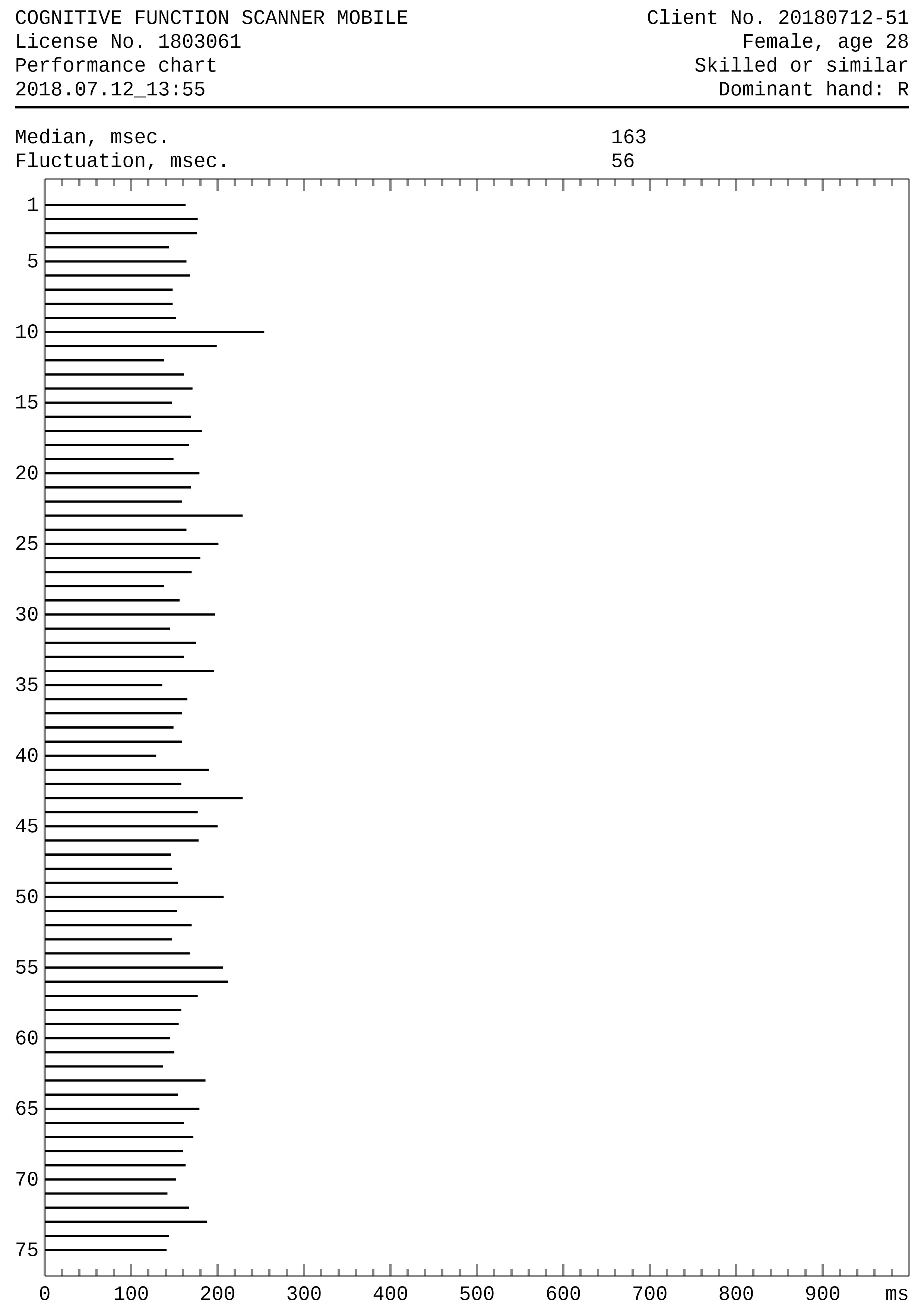
Reaction Time Test - response process chart (printable like the response process charts produced by any test in the Cognitive Function Scanner Mobile app).
The psychometric parameters of the test are:
- Median reaction-time in milliseconds (primary psychometric parameter)
- Fluctuation in milliseconds, (primary psychometric parameter).
Tests of learning and memory:
All four tests include retention sections.
Memory for faces - Face Recognition Test
The Face Recognition Test consists of three series of portraits presented on the screen of your mobile device. The portraits are of male Caucasians not known to the public. The first series includes nine portraits, which the subject is asked to look at carefully so that he or she will be able to point them out when they are presented among other portraits. Every stimulus portrait is shown for five seconds. The second series consists of 34 portraits, among which are the nine stimulus portraits. This recognition series is run immediately after completion of the first series and the subject is asked to respond "yes" or "no" to every portrait presented. The clients give their responses at their own pace via touch buttons below the pictures on the screen. Once a response is given, correction is not possible. The test also includes a retention section to be taken approximately half an hour after the the learning section.

Responding to the Face Recognition Test on a smartphone
Selection and sequence of the stimulus pictures are made according to a random procedure each time a test section is initialized in order to reduce a test re-test effect. The parameters of the test are:
Short-term/working memory:
- Number of unrecognized faces
- Number of incorrectly recognized faces
- Retrieval speed (response latencies total) in seconds
Retention:
- Number of unrecognized faces
- Number of incorrectly recognized faces
- Retrieval speed (response latencies total) in seconds
In addition to the psychometric parameters detailed recording of the client's response process is shown on a test-specific performance chart.
Memory for words - Word Recognition Test
The second test in the system is the Word Recognition Test offering 22 languages that can be selected independently of the language used for the entire examination. The languages available are Czech, Danish, Dutch, English, Faroese, Finnish, French, German, Greek, Greenlandic, Icelandic, Italian, Norwegian, Polish, Portuguese, Russian, Sami, Serbo-Croatian, Spanish, Swedish, Turkish, and Ukrainian. Test norms are established using Danish.
The Word Recognition Test is technically parallel to the Face Recognition Test, thus allowing comparison of the functioning of the two brain hemispheres. The test consists of three series of adjectives and adverbs presented on the computer screen. The first series comprises nine words, which the subject is asked to look at carefully so that he or she will be able to point them out when presented among other words. Every stimulus word is shown for five seconds. The second series consists of 34 words, among which are the nine stimulus words. This recognition series is run immediately after completion of the first series and the subject is asked to respond "yes" or "no" to every word presented. Once a response has been given, correction is not possible. The test also includes a retention section to be taken approximately half an hour after the the learning section.
The following two photos show the Word Recognition Test administered on a smartphone. The first photo shows the screen from which the language is chosen for the words to be learned. The second photo shows an example of the response screen.
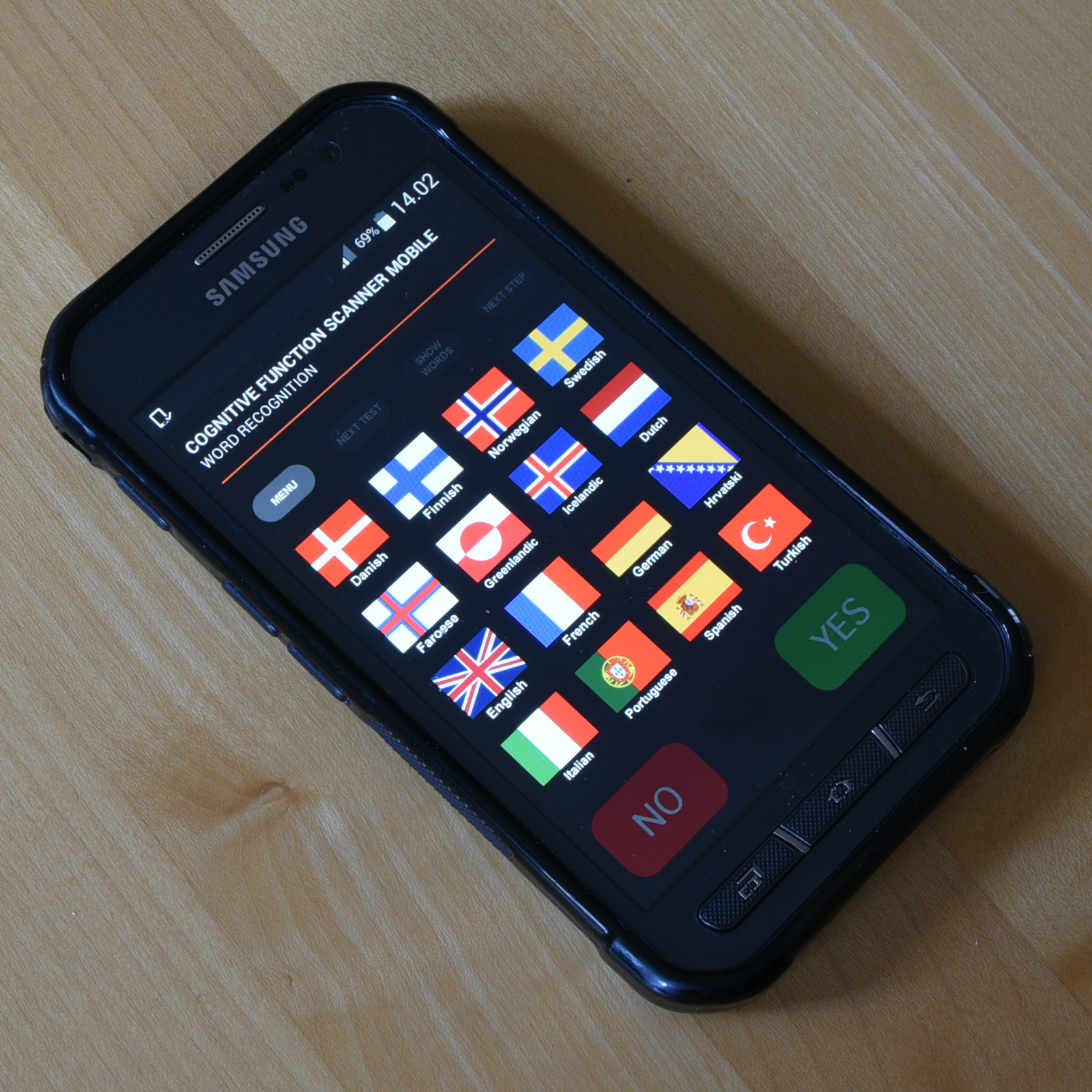
Flags guiding the choise of language independently of the language of the entire test session (client's mother tongue is recommended for the test)

Response screen of the Word Recognition Test on a smartphone
As with the Face Recognition Test selection and sequence of the stimulus words are made according to a random procedure each time a test section is initialized in order to reduce a test re-test effect. The parameters of the test are:
Short-term/working memory:
- Number of unrecognized words
- Number of incorrectly recognized words
- Retrieval speed (response latencies total) in seconds
Retention:
- Number of unrecognized words
- Number of incorrectly recognized words
- Retrieval speed (response latencies total) in seconds
In addition to the psychometric parameters detailed recording of the client's response process is shown on a test-specific performance chart.
Memory for numbers - Number Learning Test featuring selective reminding a.m. Buschke and Altman
In the Number Learning Test the task is to remember eight two-digit numbers randomly generated by the app in the interval 21-99. The numbers appear on the screen at three seconds intervals. Along with the presentation the client must read the numbers aloud to provide assurance that all eight are seen and processed. After presentation of the eighth number the client must respond by entering the numbers in any order via the numeric keyboard displayed in the right or the left side of the screen depending on the client's handedness. If some numbers are missing, only the missing numbers are displayed again. After the screen is cleared, all eight numbers must be entered again. If some are still missing, these are shown, and again the client must enter all eight numbers. The test continues with this selective reminding process until all eight numbers are entered within a single trial, or to the maximum of 10 trials.

Responding to the Number Learning Test on a smartphone. The keyboard is automatically left-alligned in case of left-handed clients
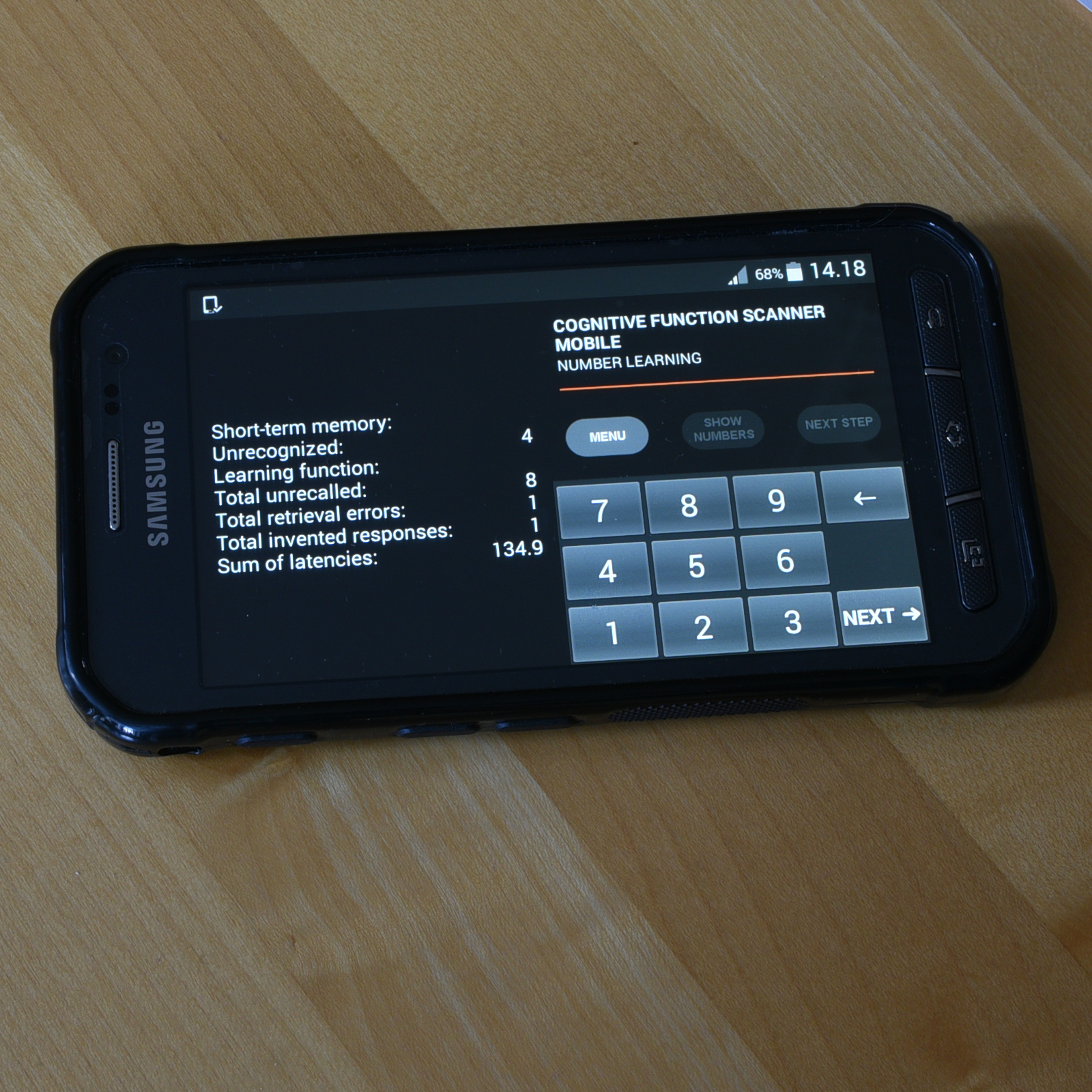
Summary result page following completion of the learning section of the Number
Learning Test on a smartphone
The number series is automatically changed each time the test is initialized.
Like the three other tests in the Cognitive Function Scanner Mobile Test Suite the Number Learning Test includes a section of retention in which the client is asked to enter the numbers he remembers from the learning section. This entry is made approximately half an hour after the learning process is completed. The parameters of the test are:
Short-term/working memory:
- Number of unrecalled numbers in the first trial
- Number of "invented" numbers in the first trial
- Number of perseverations in the first trial
- Number of unrecalled numbers in each trial
- Number of retrieval errors in each trial (i.e. numbers which have been entered at least once but for a period of time were unretrievable during the learning process)
- Number of "invented" numbers in each trial
- Number of perseverations in each trial
- Total number of unrecalled numbers
- Total number of retrieval errors
- Total number of "invented" numbers
- Total number of perseverations
- Elapsed time for learning (latencies total) in seconds
- Number of unrecalled numbers
- Number of "invented" numbers
- Number of perseverations
- Retrieval speed (response latencies total) in seconds
Learning:
Retention:
In addition to the psychometric parameters detailed recording of the client's response process is shown on a test-specific performance chart.
Memory for environmental sounds - Sound Recognition Test
The Sound Recognition Test is a new test to the Cognitive Function Scanner system. It is made over the same model as the Face Recognition Test and the Word Recognition Test but offers environmental sounds as objects. The new test is included to offer a learning and memory test suitable for the assessment of learning and memory of blind people. All sounds are authentic recordings from actual life situations.
The test consists of three series of sounds presented via the loudspeaker of the device or a set of headphones. The first series is composed of nine environmental sounds, which the client is asked to listen carefully to so that he or she will be able to point them out when presented among other environmental sounds. Every sound stimulus is presented for five seconds with a pause of two seconds to separate them from each other. The second series consists of 34 sounds, among which are the nine stimulus sounds. This recognition series is run immediately after the first series is completed. The client is asked to respond "yes" or "no" to every sound presented via two touch buttons located in the lower corners of the device making tactile navigation possible with the rim of the device as reference. Once a response is given, correction is not possible. The test also includes a retention section to be taken approximately half an hour after the the learning section.

Summary result page following completion of the retention section of the Sound Recognition Test on a smartphone
As with the Face Recognition Test and the Word Recognition Test selection and sequence of the stimulus sounds are made according to a random procedure each time a test section is initialized in order to reduce the test re-test effect. The parameters of the test are:
Short-term/working memory:
- Number of unrecognized sounds
- Number of incorrectly recognized sounds
- Retrieval speed (response latencies total) in seconds
- Number of unrecognized sounds
- Number of incorrectly recognized sounds
- Retrieval speed (response latencies total) in seconds
Retention:
In addition to the psychometric parameters detailed recording of the client's response process is shown on a test-specific performance chart.
Technical specification
The Cognitive Function Scanner Mobile Test Suite app runs on smartphones and tablets driven by the Android operating system, for example devices produced by Samsung. The app has shown to work on Android releases from version 6.0. The current version of the app takes up approximately 30 MB of the device memory.
Please note that the Figure Drawing Test, the Pen-to-Point Test, the Parallelogram Test, The Bourdon-Wiersma Test and the Continuous Graphics Test all demand a tablet featuring digital pen input, i.e., input from a sharp-tipped digital pen or pencil compatible with Samsung's S-Pens. These pencil tests appear equal in size independently of the screen resolution and physical size of the device. Currently Samsung's Galaxy tablets in the S-series with S-Pen (minimum size 9.7") are available from most computer stores.
Instead of using the S-Pen that comes along with select Samsung tablets you may want your clients to get the feeling of a genuine pencil. It can be accomplished using one of the Staedtler Noris Digital Pencils (standard pencil shape EAN 4007817035368, or the thicker model with triangular shape EAN: 4007817073933) designed for Samsung. Neither Samsung's S-Pens nor the Staedtler Noris Digital Pencils need to be charged, i.e., there is no risk of running out of power during an examination session.
The Cognitive Function Scanner Mobile Test Suite app is a stand-alone system completely independent of the Internet, telephone system or any other way of communication network. Test results are stored in client-specific files in a dedicated folder on the device from which they any time can be retrieved according to the needs of the psychologist. The result files can be printed, moved to a permanent storage, and/or be concatenated into datasets for subsequent statistical analysis.
The Cognitive Function Scanner Mobile app comes with reference values obtained by the PC-version. The reference values covering the age span from 25 to 75 years are collected via large-scale investigations of representative samples of the Danish general population, (N=1,026 and N=711), respectively.
Download and installation
The Cognitive Function Scanner Mobile Test Suite app is installed like any other app for the Android platform. As the app stores test results in files it needs access to the device's file system. It also needs access to the microphone on the device to run the Reaction Time Test as it uses sound input instead of touch technology to be fast enough to relevantly measure human reaction time. The Cognitive Function Scanner Mobile Test Suite is a stand-alone app that does not transmit any data to any place unless the user intentionally wants it.
The app is available via Google Play for users with an ip-address associated with a Nordic country, i.e., Denmark, Finland, Iceland, Norway, and Sweden. The app is double locked to prevent it from being used by layman. Only neuropsychologists and clinical psychologists are entitled to register by the developer and obtain a user license and a digital key to unlock the app.
To download and install the app click:

Please note that the pencil tests only run on Samsung Galaxy Tablets in the S-series with S Pen from model S3 and onwards.
History
The prototype to the Cognitive Function Scanner system was developed back in 1982 in the labs of the Danish National Institute of Occupational Health. The purpose was to establish an efficient, standardized, and reliable method for assessment of cognitive status of the general public, in particular people working in industries where exposure to neurotoxic substances and compounds could lead to cognitive dysfunction.
The prototype was built over a Tektronix 4052 desktop computer and a Tektronix 4956 graphics tablet. Both instruments had undergone technical modifications. As computer screens those days were monochrome a slide projector controlled by the computer was used for display of the portrait photos in one of the memory tests, the test of face recognition.
The Cognitive Function Scanner was, among other things, used in two large-scale longitudinal studies (1982-83 and 1993-94) of cognitive performance of the general Danish population. The results from these studies were published in two supplement volumes to the scientific journal Acta Neurologica Scandinavica in 1990 and 1997.
At those occasions an extensive statistical material was collected across several age groups, gender and education and a set of reference values was established for 45 psychometric parameters covering learning and memory, psychomotor functioning, visuospatial functioning, attention, perception, and vigilance. The reference values cover the age span from 25 to 75 years.
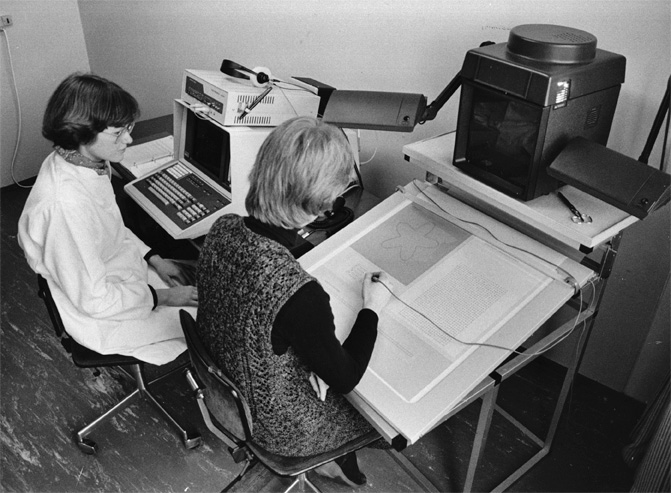
The Cognitive Function Scanner prototype. Glostrup Hospital, Denmark 1982
In 1988 the Cognitive Function Scanner came commercially available for the PC-platform. Due to its efficienvy and precision it soon found its way into the clinical psychological units in university hospitals and district hospitals all over the Nordic countries. For decades the technical solutions of the system together with its unparalleled set of reference values probably made the Cognitive Function Scanner to the most distinctive system of its kind.
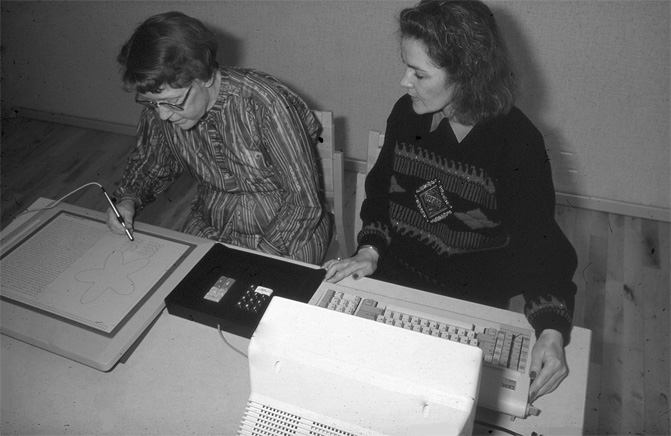
The first commercially available Cognitive Function Scanner for the PC, 1989
In addition to learning and memory tests the prototype and all releases of the Cognitive Function Scanner for the PC-environment included tests of visuomotor functioning, visuospatial functioning, attention, vigilance and concentration to ensure a high degree of comprehensiveness and ecological validity of the battery. These tests were done by means of very accurate graphics tablets featuring digital pens resembling ordinary ballpoint pens.
With the introduction of the Cognitive Function Scanner release 3-1 in 1996 a detailed time-linked continuous recording of the response process was included. In complex diagnostic cases these qualitative data can act as a valuable support for interpretation of the psychometric results.
Especially for the testing of reaction-time in relation to acquisition or renewal of a driving license, a stand-alone version of the continuous Reaction Time Test was introduced by the late 1990s and marketed as the RT-Profile Test.
With introduction of mobile computers, tablets, and smartphones demands to portable and highly efficient neuropsychological test systems has increased. Today the Cognitive Function Scanner for the PC is replaced by the Cognitive Function Scanner Mobile app for tablets and to some extent smartphones. Like the original system, the mobile version is a comprehensive state-of-the-art assessment tool of learning and memory and of divers executive functions.
Cognitive Function Scanner Mobile is an application for use exclusively by professional neuropsychologists. To run the application the user needs a user license key and a validation key from the developer. License keys and validation keys are supplied only to neuropsychologists who can prove their qualifications.
The purpose of the Cognitive Function Scanner Mobile application is to provide a standardised, efficient, and reliable instrument for testing neuropsychological functioning of humans, i.e., to provide indicators of memory, attention, perception, visuomotor functioning and visuospatial functioning. To do so the Cognitive Function Scanner Mobile application collects data during the testing and stores these data into files on the test device.
During the test of reaction time the microphone of the device is active. The microphone is used to detect the onset of sound stimuli and of client responses, respectively. The reason for using sound as 'stimulus-response-carrier' is that touchscreen technology is too slow and imprecise in relation to normal human reaction time. No sound information received by the device is stored by the application, and because the app doesn't have permission for Internet access during the testing, no sound information leaves the test device.
The examining neuropsychologist has the full and entire responsibility at all times for all data entered or otherwise recorded by the application. No information is automatically transmitted by the application to any external party, neither to the developer of the application nor to anybody else.
Q: In your photos on this website you use what looks like a wooden pencil. Can an ordinary pencil
be used on the tablet?
A: No, an ordinary pencil cannot be used on the tablet, but the German pencil producer Staedtler
makes digital pencils that can replace the S Pen. It has EAN number 4007817035368. It is such a
pencil you see in the photos.
Q: Is it possible to obtain a Samsung S Pen and use it on a tablet that did not include the S Pen
from the beginning?
A: No, it is not possible, because Samsung use a different technology (magnetic resonance) for
their tablets with S Pen compared to 'ordinary' tablets using only touch technology (capacitive
technology).
Q: When a person draws or writes the person usually rests a hand on the item on which the drawing
or writing takes place. Is it possible to rest one's fingers or hand on the tablet screen while
doing the pen-based tests?
A: Yes, it is possible to rest fingers/hands on the screen during the pen-based tests. The tablet
is in pen mode and is immune to finger/hand touching.
Q: Does the Cognitive Function Scanner deal with standardised scores or raw scores?
A: The Cognitive Function Scanner only deals with raw scores that can be understood right away.
Q: Does your test suite produce any texted evaluation of the test outcomes?
A: No, the Cognitive Function Scanner is for use by professionals only. Evaluation of an
examination across several cognitive domains is a complicated task also involving information
from other sources than just test outcomes.
Q: How does the Cognitive Function Scanner comply with the EU General Data Protection Regulation
(GDPR)?
A: Cognitive Function Scanner is not an online system. The tablet or smartphone used for
the testing must be disconnected from any network during the entire examination. No data are sent
anywhere at any time unless the user intentionally transmits an examination protocol to a permanent
storage system or the like. The user is urged to delete completed examination protocols from the
test device. Contrary to online digital psychological test systems all data obtained by Cognitive
Function Scanner remain the sole property of the psychologist, who has taken the tests, and
consequently, who is fully responsible that the EU GDPR is followed.
Q: Can I use the CFS on a tablet computer or a PC?
A: Cognitive Function Scanner for the PC-platform is discontinued. The current 4th generation is
developed for the Android platform (tablets and cellular phones). All memory tests and the
Reaction Time Test run on cellular phones provided thay are powered by Android. The pencil tests
run exclusively on Samsung Galaxy tablets in the S-series. Such tablets are avalable from any
computer store. Tablets running other operating systems cannot be used.
Q: Are most of the reference material from the 1980s?
A: The built-in reference material is based on representative samples of the general population
drawn via the Danish National Citizen Registry. The reference material is culture neutral and
practically timeless. References for the youngest age group fra 25 to 35 years are collected in the
mid 1980s while the references for the older age groups are collected in mid 1990s (N=1,026 and
N=711 respectively). A new round of data collection has begun in 2023 and will be included when
completed probably in 2025.
Andersen R. Cognitive changes after amygdalotomy. Neuropsychologia 1978; 16: 439-451.
Anderson KE, Perera GM, Hilton J, Zubin N, Paz RD, Stern Y. Functional magnetic resonance imaging study of word recognition in normal elders. Progress in Neuro-Psychopharmalogy & Biological Psychiatry 2002; 26: 647-50.
Baddeley AD, Lewis V, Vallar G. Exploring the articulatory loop. Quarterly Journal of Experimental Psychology 1984; 36: 233-252.
Bartolomeo P, de Schotten MT, Chica AB. Brain networks of visuospatial attention and their disruption in visual neglect. Frontiers in Human Neuroscience 2012; 6: 110.
Behrmann M, Plaut DC. Bilateral hemispheric processing of words and faces: Evidence from word impairments in prosopagnosia and face impairments in pure alexia. Cerebral Cortex 2014; 24: 1102-1118.
Bourdon B., Wiersma ED, (1910) The Bourdon Wiersma Test. CoTAN: 2000 I: 532 (28.1); 1992 (28.1).
Brun B, Knudsen P. Psykologisk undersøgelsesmetodik - En basisbog. 2. reviderede udgave, København 2006; Dansk Psykologisk Forlag.[Psychological Assessment Methodology, 2nd revised edition. Copenhagen 2006: Danish Psychological Publishers].
Buschke H, Fuld PA. Evaluating storage, retention, and retrieval in disordered memory and learning. Neurology 1974: 24; 1019-1025.
Colette F, Van der Linden M. Review brain imaging of the central executive component of working memory. Neuroscience & Biobehavioral Reviews 2002; 26: 105-25.
Degerman A, Rinne T, Salmi J, Salonen O, Alho K. Selective attention to sound location or pitch studied with fMRI. Brain Research 2006; 1077: 123-34.
Dehaene S, Piazza M, Pinel P, Cohen L. Three parietal circuits for number processing. Cognitive Neuropsychology 2003; 20: 487-506.
Elsass P. Continous reaction times in cerebral dysfunction. Acta Neurologica Scandinavica 1986; 73: 225-46.
Engel LR, Frum C, Puce A, Walker NA, Lewis JW. Different categories of living and non-living sound-sources activate distinct cortical networks. Neuroimage. 2009; 47: 1778-91.
Gerlach C, Marstrand L, Starrfelt R, Gade A. No strong evidence for lateralisation of word reading and face recognition deficits following posterior brain injury. Journal of Cognitive Psychology 2014; 26: 550-558.
Gowen E, Miall RC. Differentiation between external and internal cuing: An fMRI study comparing tracing with drawing. NeuroImage 2007; 36: 396-410.
Grabowska A, Gut M, Binder M, Forsberg L, Rymarczyk K, Urbanik A. Switching handedness: fMRI study of hand motor control in right-handers, left-handers and converted left-handers. Acta Neurobiologiae Experimentalis 2012; 72: 439-51.
Grewel F. The Bourdon-Wiersma Test. Folia Psychiatrica, Neurologica et Neurochirurgica Neerlandica. 1953; 56: 694-703.
Halari R, Sharma T, Hines M, Andrew C, Simmons A, Kumari V. Comparable fMRI activity with differential behavioural performance on mental rotation and overt verbal fluency tasks in healthy men and women. Experimental Brain Research 2006; 169: 1-14.
Hall D, Haggard MP, Akeroyd MA, Summerfield AQ, Palmer AR, Elliot MR, Bowtell RW. Modulation and task effects in auditory processing measured using fMRI. Human Brain Mapping 2000; 10: 107-19.
Hänninen H, Lindström K. Behavioral test battery for toxicopsychological studies. Reviews 1. Helsinki: Institute of Occupational Health, 1979.
Harrington GS, Farias D, Davis CH, Buonocore MH. Comparison of the neural basis for imagined writing and drawing. Human Brain Mapping 2007; 28: 450-59.
Haxby JV, Hoffman EA, Gobbini MI. The distributed human neural system for face perception, Trends in Cognitive Sciences 2000; 4: 223-33.
Jahanshahi M, Dirnberger G, Fuller R, Frith CD. The role of dorsolateral prefrontal cortex in random number generation: a study with positron emission tomography. Neuroimage 2000; 12: 713-25.
Johnson SC, Saykin AJ, Flashman LA, McAllister TW, Sparling MB. Brain activation of fMRI and verbal memory ability: functional neuroanatomic correlates of CVLT performance. Journal of the International Neuropsychological Society 2001; 7: 55-62.
Jueptner J, Jueptner M, Jenkins IH, Brooks DJ, Frackowiak RSJ, Passingham RE. The sensory guidance of movement: a comparison of the cerebellum and basal ganglia. Experimental Brain Research 1996; 112: 462-74.
Kanwisher N, McDermott J, Chun MM. The fusiform area; A module in human extrastriate cortex specialized for face perception. Journal of Neuroscience 1997; 17: 4302-11.
Kaplan E. A process approach to neuropsychological assessment. In: Boll T, Bryant BK (eds.) Clinical Neuropsychology and Brain Function Research, Measurement, and Practice. Washington DC: APA 1988, 129-67.
Karimpoor M, Churchill N, Tam F, Fischer C, Schweizer T, Graham S. Neural correlates of handwriting. Conference poster at Organization for Human Brain Mapping, Vancouver 2017: June 28-29.
Kim JJ, Andreasen NC, O’Leary DS, Wiser AK, Boles Ponto LL, Watkins GL, Hichwa RD. Direct comparison of the neural substrates of recognition memory for words and faces. Brain 1999; 122: 1069-83.
Kleinschmidt A, Cohen L. The neural bases of prosopagnosia and pure alexia: recent insights from functional neuroimaging, Current Opinion in Neurology 2006; 19: 386-91.
Knops A, Nuerk H-C, Fimm B, Vohn R, Willmes K. A special role for numbers in working memory? An fMRI study. Neuroimage 2006; 29: 1-14.
Lamm C, Windischberger C, Moser E, Bauer H. The functional role of dorso-lateral premotor cortex during mental rotation: An event-related fMRI study separating cognitive processing steps using a novel task paradigm. Neuroimage 2007; 36: 1374-86.
Langner R, Eickhoff SB. Sustaining attention to simple tasks: A meta-analytic review of the neural mechanisms of vigilant attention. Psychological Bulletin 2013; 139: 870-900.
Laursen P, Eskelinen L. Information process recording and psychometrics in computer-aided neuropsychological assessment. The 4th Nordic Neuropsychology Symposium, Espoo, Finland, August 1991.
Laursen P, Eskelinen L. The Cognitive Function Scanner: A computer-aided psychological examination system for neuropsychological evaluation. Journal of Clinical and Experimental Neuropsychology 1989; 3: 365.
Laursen P, Eskelinen L. The Cognitive Function Scanner: A computer-aided psychological examination system for neurobehavioral evaluation. In Johnson BL, ed. Advances in Neurobehavioral Toxicology: Applications in Environmental and Occupational Health. Chelsea: Lewis Publishers Inc., 1990.
Laursen P. A computer-aided technique for testing cognitive functions validated on a sample of Danes 30 to 60 years of age. Acta Neurologica Scandinavica 1990; vol. 82, suppl. 131.
Laursen P. The impact of aging on cognitive functions. An 11 year follow-up study of four age cohorts, Acta Neurologica Scandinavica 1997; vol. 96, suppl. 172.
Lewis JW, Wightman FL, Brefczynski JA, Phinney RE, Binder JR, DeYoe EA. Human brain regions involved in recognizing environmental sounds. Cerebral Cortex 2004; 14: 1008-21.
Lezak MD. IQ: R.I.P. Journal of Clinical and Experimental Neuropsychology 1988; 10: 351-361.
Maeder PP, Meuli RA, Adriani M, Bellmann A, Fornari E, Thiran JP, Pittet A, Clarke S. Distinct pathways involved in sound recognition and localization: a human fMRI study. Neuroimage 2001; 14: 802-16.
Makuuchi M, Kaminaga T, Sugishita M. Both parietal lobs are involved in drawing: a functional MRI study and implications for constructional apraxia. Brain Research. Cognitive Brain Research 2003; 16: 338-47.
Marcell MM1, Borella D, Greene M, Kerr E, Rogers S. Confrontation naming of environmental sounds Journal of Clinical and Experimental Neuropsychology 2000; 22: 830-64.
Marshall L, Brandt JF. The relationship between loudness and reaction time in normal hearing listeners. Acta Otolaryngology 1980; 90: 244-249.
McCandliss BD, Cohen L, Dehaene S. The visual word form area: expertise for reading in the fusiform gyrus, Trends in Cognitive Sciences, 2003; 7: 293-99.
Miall RC, Reckess GZ, Imamizu H. The cerebellum coordinates eye and hand tracking movements. Nature Neuroscience 2001; 4: 638-44.
Milberg WP, Hebben N, Kaplan E. The Boston Process Approach to Neuropsychological Assessment. In Grant I, Adams KM eds. Neuropsychological Assessment of Neuropsychiatric Disorders. New York: Oxford University Press, 1986, pp. 65-86.
Mort DJ, Malhotra P, Mannan SK, Rorden C, Pambakian A, Kennard C, Husain M. The anatomy of visual neglect. Brain 2003; 126: 1986-97.
Nichols EA, Kao YC, Verfaellie M, Gabrieli JDE. Working memory and long-term memory for faces: Evidence from fMRI and global amnesia for involvement of the medial temporal lobes. Hippocampus 2006; 16: 604-16.
Ogawa K, Inui T, Sugio T. Separating brain regions involved in internally guided and visual feedback control of moving effectors: An event-related fMRI study. Neuroimage 2006; 32: 1760-70.
Ogawa K, Inui T. The role of the posterior parietal cortex in drawing by copying. Neuropsychologia 2009; 47: 1013-22.
Ogawa K, Nagai C, Inui T. Brain mechanisms of visuomotor transformation based on deficits in tracing and copying. Japanese Psychological Research 2010; 52: 91-106.
Park J, Hebrank A, Polk TA, Park DC. Neural dissociation of number from letter recognition and its relationship to parietal numerical processing. Journal of Cognitive Neuroscience 2012; 24: 39-50.
Petersen SE, Corbetta M, Miezin FM, Schulman GL. PET studies of parietal involvement in spatial attention: Comparison of different task types. Canadian Journal of Experimental Psychology 1994; 48: 319-338.
Petit L, Simon G, Jolio M, Andersson F, Bertin T, Zago L, Mellet E, Tzourio-Mazoyer N. Right hemisphere dominance for auditory attention and its modulation by eye position: An event related fMRI study. Restorative Neurology and Neuroscience 2007; 25: 211-25.
Planton S, Jucla M, Roux FE, Demonet J. The “handwriting brain”: A meta-analysis of neuroimaging studies of motor versus orthographic processes. Cortex 2013; 49: 2772-87.
Planton S, Longcamp M, Péran P, Démonet J-F, Jucla M. How specialized are writing-specific brain regions? An fMRI study of writing, drawing and oral spelling. Cortex 2017; 88: 66-80.
Ratcliff R. Methods for dealing with reaction time outliers. Psychological Bulletin 1993; 114: 510-32.
Rajimehr R, Young JC, Tootell RBH. An anterior temporal face patch in human cortex, predicted by macaque maps. Proceedings of the National Academy of Sciences 2009; 106: doi: 10.1073 pnas. 0807304106.
Richter W, Somorjai R, Summers R, Jarmasz M, Menon RS, Gati JS, Georgopoulos P, Tegeler C, Ugurbil K, Kim S-G. Motor area activity during mental rotation studied by time-resolved single-trial fMRI. Journal of Cognitive Neuroscience 2000; 12: 310-20.
Rizzolatti G, Luppino G, Matelli M. The organization of the cortical motor system: new concepts. Electroencephalographic Clinical Neurophysiology 1998; 106: 283-96.
Roux FE, Dufor O, Giussani C, Wamain Y, Draper L, Longcamp M, Démonet JF. The graphemic/motor frontal area Exner’s area revisited. Annals of Neurology 2009; 66: 537-45.
Salmi J, Rinne T, Koistinen S,Salonen O, Alho K. Brain networks of bottom-up triggered and top-down controlled shifting of auditory attention. Brain Research 2009; 1286: 155-64.
Sams T, Laursen P, Eskelinen L. Response classification in psychological testing using a neural network. International Journal of Neural Systems 1994; 5: 253-56.
Schaer K, Jahn G, Lotze M. fMRI-activation during drawing a naturalistic or sketchy portrait. Behavioural Brain Research 2012; 233: 209-16.
Segal E, Petrides M. The anterior superior parietal lobule and its interactions with language and motor areas during writing. European Journal of Neuroscience 2012; 35: 309-22.
Sturm W, Willmes K. On the functional neuroanatomy of intrinsic and phasic alertness. Neuroimage 2001; 14: S76-84.
Theofilou G, Ladakis I, Mavroidi C, Kilintzis V, Mirachtsis T, Chouvarda I, Kouidi E. The effects of a visual stimuli training program on reaction time, cognitive function, and fitness in young soccer players. Sensors 2022; 22: 6680.
Thimm M, Fink GR. Kuuml;st J, Karbe H, Sturm W. Impact of alertness on spatial neglect: A behavioural and fMRI study. Neuropsychologia 2006; 44: 1230-1246.
Tomasino B, Canderan C, Marin D, Maieron M, Gremese M, D’Agostini S, Fabbro F, Skrap M. Identifying environmental sounds: a multimodal mapping study. Frontiers in Human Neuroscience 2015; 9: https://doi.org/10.3389/fnhum.2015.00567.
Voisin J, Bidet-Caulet A, Bertrand O, Fonlupt P. Listening in silence activated auditory areas: A functional magnetic resonance imaging study. Journal of Neuroscience 2006; 26: 273-78.
Wang TY, Huang HC, Huang HS. Design and implementation of cancellation tasks for visual search strategies and visual attention in school children. Computers and Education 2006; 47: 1-16.
Warrington EK, Taylor AM. Immediate memory for faces: long- or short-term memory? Quarterly Journal of Experimental Psychology 1973: 25; 316-322.
Western SL, Long CJ. Relationship between reaction time and neurophysiological test performance. Archives of Clinical Neuropsychology 1996; 11: 557-571.
Yuan Y, Brown S. The neural basis of mark making: a functional MRI study of drawing. PLOS One 2014; 9: 0108628.
Zacks JM. Neuroimaging studies of mental rotation: A meta-analysis and review. Journal of Cognitive Neuroscience 2008; 20: 1-19.
